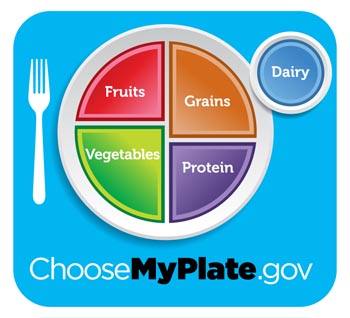How Does Your Plate Compare to MyPlate?
 by Leah McGrath, RD, LDN – Ingles Dietitian
by Leah McGrath, RD, LDN – Ingles Dietitian
The USDA (United States Department of Agriculture) recently introduced their new icon to illustrate the 2010 Dietary Guidelines.
This new icon shows a plate divided into portions for protein, grains, vegetables and fruit with a small circle on the upper right to represent dairy. This means that more than half your dinner or lunch plate should be composed of fruits/vegetables.
Many feel that this sort of plate graphic will better demonstrate how we should be eating and encourage Americans to consume more fruits and vegetables.
The USDA website guides you through your questions about “MyPlate” and also provides a variety of helpful resources and tools including:
1. How to look up foods to see what group they belong in on your plate.
2. Learning about the different food groups.
3. Making up your own food plant.
4. Assessing your diet and physical activity.
5. Planning a healthy menu.
www.ChooseMyPlate.gov
Foods in the Fruit Group
Any fruit or 100% fruit juice counts as part of the Fruit Group. Fruits may be fresh, canned, frozen, or dried, and may be whole, cut-up, or pureed.
Foods in the Grains Group
Any food made from wheat, rice, oats, cornmeal, barley or another cereal grain is a grain product. Bread, pasta, oatmeal, breakfast cereals, tortillas, and grits are examples of grain products.
Foods in the Vegetable Group
Any vegetable or 100% vegetable juice counts as a member of the Vegetable Group. Vegetables may be raw or cooked; fresh, frozen, canned, or dried/dehydrated; and may be whole, cut-up, or mashed.
Foods in the Protein Food Group
All foods made from meat, poultry, seafood, beans and peas, eggs, processed soy products, nuts, and seeds are considered part of the Protein Foods Group. Beans and peas are also part of the Vegetable Group.
Select a variety of protein foods to improve nutrient intake and health benefits, including at least 8 ounces of cooked seafood per week. Young children need less, depending on their age and calories needs. The advice to consume seafood does not apply to vegetarians. Vegetarian options in the Protein Foods Group include beans and peas, processed soy products, and nuts and seeds. Meat and poultry choices should be lean or low-fat.
Foods in the Dairy Group
All fluid milk products and many foods made from milk are considered part of this food group. Most Dairy Group choices should be fat-free or low-fat.
Foods made from milk that retain their calcium content are part of the group. Foods made from milk that have little to no calcium, such as cream cheese, cream, and butter, are not. Calcium-fortified soymilk (soy beverage) is also part of the Dairy Group.
From USDA’s Website www.choosemyplate.gov








